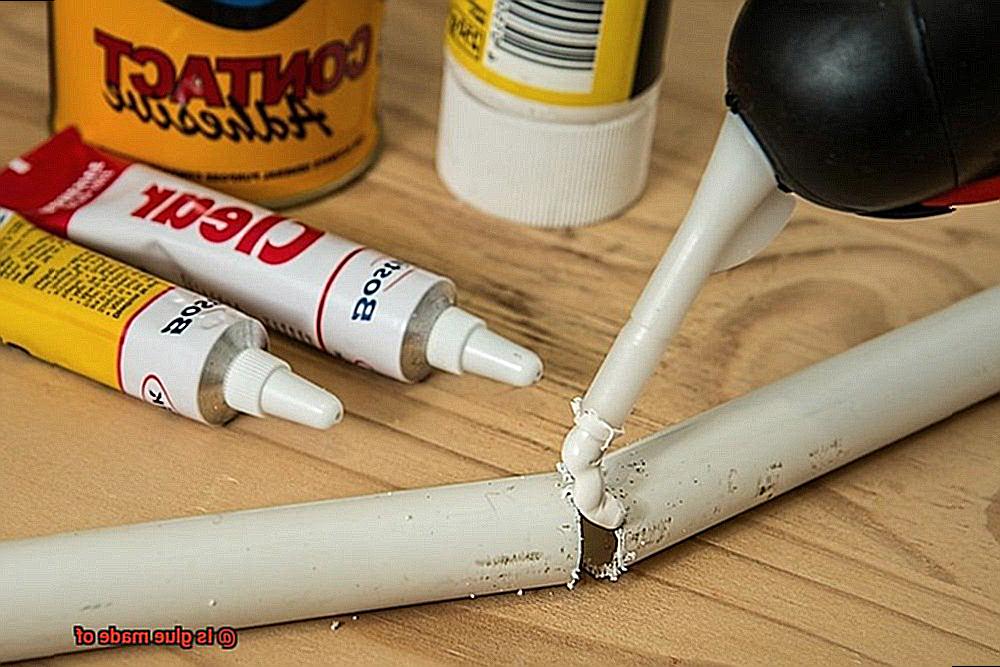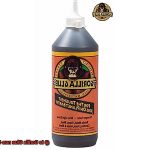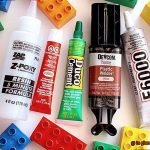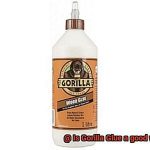Ever wondered what makes glue so sticky?
Whether you’re a craft fanatic, a DIY devotee, or just plain curious about everyday stuff, knowing what goes into making glue is not only mind-blowing but also gives you mad respect for this must-have adhesive. Glue is like the superhero of school projects and home repairs, saving the day for centuries.
But what’s its secret sauce? In this blog post, we’ll spill the beans on the key ingredients that make glue stick like crazy.
So buckle up and get ready to dive deep into the wild world of glue-making.
The Main Ingredient: Resins
Contents
Glue is a marvel of chemistry, allowing us to unite materials in countless ways. But what makes glue sticky and adhesive? The answer lies in its main ingredient: resins. In this article, we will delve into the fascinating world of resins, exploring their properties and significance in glue production.
The Sticky Nature of Resins:
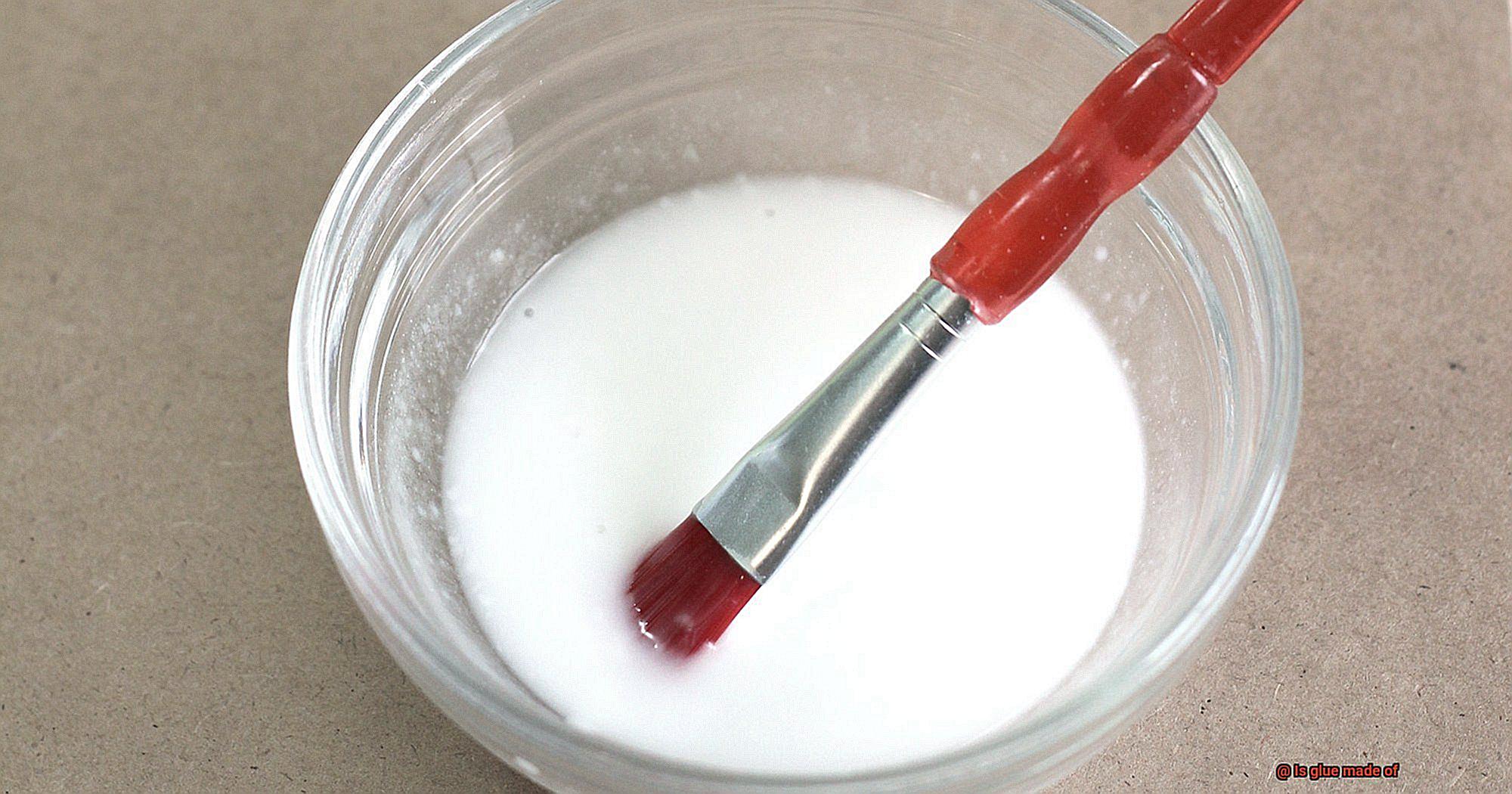
Resins, whether natural or synthetic, possess a distinct stickiness that enables them to adhere to surfaces. Their viscous nature forms a robust bond between materials, ensuring a secure hold. This adhesive property is crucial for glue, making it capable of sticking to various surfaces with remarkable tenacity.
Natural Resins:
Obtained through a process called tapping from trees and plants, natural resins have played a pivotal role in glue-making for centuries. Pine resin, rosin, and gum arabic are just a few examples of these organic wonders. Not only do natural resins offer exceptional adhesion, but they also provide an eco-friendly and sustainable option for glue production.
Synthetic Resins:
Synthetic resins, in contrast, are created through chemical processes using petroleum or other sources. These man-made resins offer versatility in terms of their properties and characteristics. They can be tailored to meet specific requirements, such as increased flexibility or water resistance, expanding the possibilities for glue applications.
Hardening and Strength:
Resins possess the remarkable ability to harden or solidify when exposed to specific conditions like heat or moisture. This transformative quality allows glue to form an unyielding bond between materials, imparting durability and strength. With the help of resins, glued objects can withstand stress and strain without compromising their integrity.
Enhancing Properties:
Beyond their adhesive prowess, resins can enhance other vital characteristics of glue. For instance, they contribute to flexibility, enabling slight movements without compromising the bond’s stability. Resins also improve water resistance, ensuring that glue remains effective even in damp or humid conditions. Moreover, they influence the drying time of glue, facilitating efficient and timely application.
Solvents and Water
Glue, a remarkable substance that binds our world together, is the unsung hero behind our creative endeavors and repairs. But have you ever wondered about the magic behind glue’s sticky properties? In this captivating exploration, we will delve into the fascinating role of solvents and water in the creation of glue. So put on your goggles and prepare to embark on a scientific journey that will reveal the secrets of this adhesive wonder.
Solvents: The Masters of Bonding
Solvents are the glue whisperers, skillfully guiding the adhesive components to create a cohesive mixture. Here are some intriguing facts about solvents:
- Organic solvents like acetone, toluene, or ethanol are often employed in solvent-based glues, showcasing their versatile nature.
- These solvents expertly control the viscosity or thickness of glue, ensuring it is perfect for application.
- Different types of glues require specific solvents tailored to their unique chemical compositions.
Water: The Gentle Medium
Water-based glues, known as emulsion adhesives, have gained immense popularity due to their eco-friendly nature. Here’s why water is an essential ingredient in glue:
- Water acts as a medium for dispersing adhesive particles or polymers within the glue, allowing for even distribution.
- Polymers such as polyvinyl acetate (PVA) or polyvinyl alcohol (PVOH) dissolve or disperse in water.
- When applied to a surface, water gracefully evaporates, leaving behind a thin layer of adhesive that forms an unbreakable bond.
Choosing the Perfect Glue
The decision between solvent-based and water-based glues depends on several factors:
- Solvent-based glues offer rapid drying times and exceptional initial bond strength but may emit volatile organic compounds (VOCs).
- Water-based glues, on the other hand, are non-toxic and effortless to clean up, making them a preferred choice in various industries.
- When selecting glue, consider the materials being bonded, desired bond strength, and the impact on the environment.
Thickening Agents
Enter the world of thickening agents – the unsung heroes responsible for transforming liquid adhesives into the perfect sticky substances. In this article, we will embark on a captivating journey into glue production and explore the pivotal role of these agents in creating exceptional adhesives.
Polyvinyl Alcohol (PVA):
- PVA stands tall as one of the most popular thickening agents in glue production.
- When mixed with water, this synthetic polymer forms a thick gel-like substance that prevents dripping or running.
- Boasting excellent adhesive properties, PVA lends itself to a broad range of applications, making it a go-to choice for many glue formulations.
Cellulose Derivatives:
- Derived from plant fibers, cellulose derivatives such as methylcellulose and carboxymethylcellulose are commonly employed as thickening agents.
- These water-soluble agents have a remarkable ability to absorb water and create a gel-like substance that imparts the desired consistency to glue.
- Additionally, they prevent the glue from spreading too thinly, facilitating easier application.
Starch:
- A cost-effective and readily available option, starch derived from plants serves as both a binder and thickener in glue production.
- By lending its unique properties to glue formulations, starch ensures optimal consistency and enhances adhesive strength, resulting in robust bonds between materials.
Gelatin:
- Derived from animal collagen, gelatin occasionally finds its way into certain types of glue as a thickening agent.
- Offering exceptional adhesive properties and flexibility, gelatin is particularly suitable for applications requiring some degree of movement or flexibility.
Additional Additives:
- The formulation of glue may also incorporate other additives, such as plasticizers, preservatives, colorants, and fillers.
- These additional components serve to enhance specific properties of the glue, such as flexibility or longevity.
Additives to Enhance Adhesive Properties
In this article, we will explore how additives play a crucial role in enhancing the adhesive properties of glues. From improving bond strength to increasing flexibility and durability, these additives work their magic to create exceptional adhesives.
Plasticizers for Flexibility and Bond Strength:
One of the commonly used additives in glues is plasticizers. These substances increase the flexibility of the adhesive, preventing it from becoming brittle over time. Plasticizers also enhance bond strength by allowing the glue to conform better to irregular surfaces. So whether you’re bonding two different materials or dealing with uneven surfaces, plasticizers come to the rescue.
Tackifiers for Initial Adhesion:
When it comes to pressure-sensitive adhesives, like those used in tapes and labels, tackifiers are the heroes. These additives increase the initial adhesion of the glue, ensuring a strong bond right from the start. So the next time you peel off a sticker effortlessly or rely on tape for packaging, thank tackifiers for their role in securing your belongings.
Fillers for Strength and Stiffness:
To enhance the strength and stiffness of glues, fillers are added to the formulations. Silica, talc, and calcium carbonate are some examples of fillers used in glues. These fillers reinforce the glue, making it suitable for applications that require extra strength and rigidity.
Chemical Agents for Specific Properties:
Glue formulations can incorporate various chemical agents to improve specific properties. Crosslinking agents, for example, increase the adhesive’s resistance to heat and moisture, making it suitable for outdoor applications or demanding environments. UV stabilizers prevent degradation when exposed to sunlight, ensuring long-lasting bonds.
Modifying Curing Time:
Additives can also modify the curing time of the glue. Accelerators speed up the curing process, which is beneficial when you need quick results. On the other hand, retarders slow down the curing process, allowing for adjustments and repositioning.
Preservatives to Prolong Shelf Life
One of the key ingredients that ensures the longevity of glue products is preservatives. In this blog post, we’ll dive into the world of preservatives and explore how they work their magic to extend the shelf life of glue.
Preserving Against Microbial Menaces:
Preservatives are essential in preventing the growth of bacteria, fungi, and other microorganisms that can spoil or degrade adhesive products. Glue, being made up of organic materials like proteins, collagen, or gelatin, provides a perfect breeding ground for these pesky microbes.
Enter formaldehyde, a widely used preservative in glue. It acts as a disinfectant and antimicrobial agent, disrupting cellular processes and inhibiting reproduction. With formaldehyde on guard, those microbial menaces don’t stand a chance.
BIT by BIT, We Preserve:
But formaldehyde isn’t the only hero in town. Another powerful preservative is benzisothiazolinone (BIT). This synthetic compound packs a punch with its excellent antimicrobial properties. By damaging cell membranes and interfering with enzymatic processes, BIT keeps mold and yeast at bay. It’s like an invisible shield protecting your glue from the forces of decay.
And let’s not forget about methylisothiazolinone (MIT), another trusty preservative. MIT works as a broad-spectrum antimicrobial agent, disrupting microbial cells and metabolism. It’s like a one-two punch against those pesky germs.
Considerations and Safety:
While preservatives are crucial for extending shelf life, it’s important to consider potential allergenic properties. Some individuals may be sensitive or allergic to certain preservatives like formaldehyde or specific isothiazolinones. Manufacturers must adhere to safety regulations and labeling requirements to ensure consumer awareness. After all, we want to keep everyone safe and happy while they’re enjoying their glue projects.
Different Types of Glue and Their Ingredients
Well, get ready to be amazed as we delve into the different types of glue and their special ingredients. From PVA to super glue, epoxy to hot glue, and wood glue to contact cement, we will uncover the secrets behind these adhesives and their magical properties.
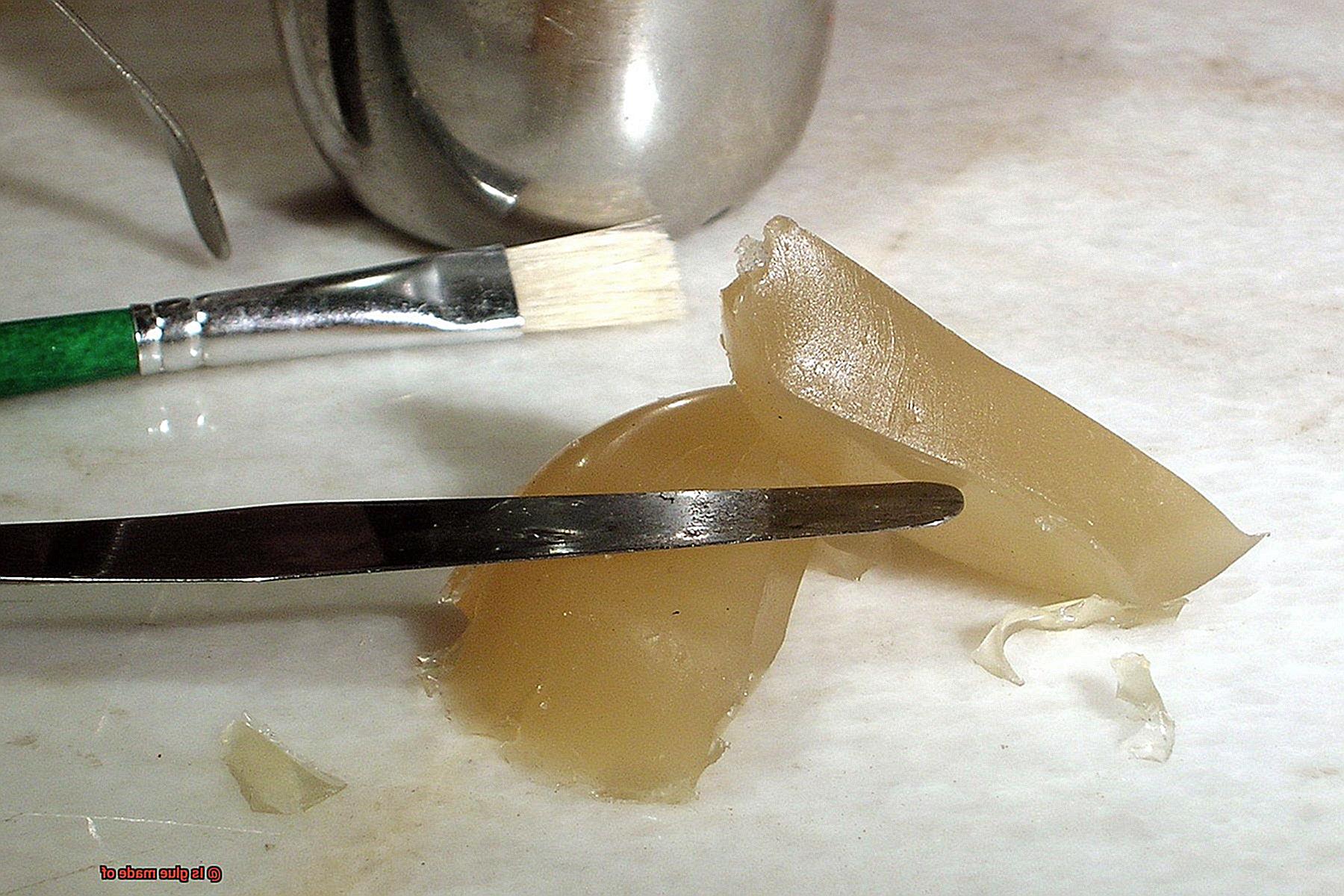
PVA Glue: The Clear Champion
PVA glue is like an invisible superhero that saves the day in arts and crafts projects. Made from a special mixture of polyvinyl acetate polymer and water, it dries clear, making it perfect for those times when you don’t want the glue to be seen. Whether you’re working on a transparency masterpiece or creating a secret message, PVA glue has got your back.
Super Glue: The Speedy Sidekick
When you need things to stick together in a flash, super glue comes to the rescue. Its secret ingredient is cyanoacrylate monomer, which reacts with moisture in the air to form a bond so strong it feels like magic. From fixing broken toys to mending jewelry, super glue is always ready for action.
Epoxy: The Tough Warrior
If you need a bond that can withstand anything, epoxy is your go-to adhesive. This powerful two-part adhesive combines a resin and a hardener in a chemical reaction that creates an unbreakable bond. Made from compounds like bisphenol-A and amines or polyamines, epoxy is tough enough to handle whatever challenges come its way.
Hot Glue: The Crafty Magician
When it comes to crafts and DIY projects, hot glue works its magic. Made from a special polymer called ethylene-vinyl acetate (EVA), hot glue melts when heated and solidifies when cooled. It’s like having a wand that can instantly stick things together. With hot glue, you can create amazing crafts and fix things in a snap.
Wood Glue: The Lumber Master
Wood glue is specially designed for bonding wood surfaces with strength and resilience. Its main ingredient is usually PVA, just like regular white glue, but with some extra oomph. Resins and fillers are added to make wood glue super strong and resistant to moisture and temperature changes. So, whether you’re building a wooden masterpiece or fixing a broken chair leg, wood glue has got your back.
Contact Cement: The Instant Uniter
When you need a bond that happens in an instant, contact cement is here to save the day. Its secret weapon is neoprene rubber, which provides excellent adhesion properties. When two surfaces coated with contact cement meet, they instantly bond together. No waiting around or holding things in place – just an instant union that’s as strong as can be.
The Science Behind Glue
Prepare to be amazed as we delve into the fascinating world of glue and uncover the science behind its incredible bonding powers. Glue, that sticky substance that binds objects together, owes its adhesive properties to the magic of polymers. Polymers, those long chains of molecules, are the heroes in the glue story. They give glue its superpower.
The most common type of glue is known as PVA (polyvinyl acetate) glue, made from vinyl acetate monomer. Through a chemical reaction called polymerization, vinyl acetate monomer transforms into strong polymer chains that make up the glue.
But polymers aren’t the only heroes in this story. Water plays a crucial role too. It acts as a solvent, controlling the thickness or viscosity of the glue. Furthermore, water aids in the curing process of certain glues. As it evaporates, it allows the glue to harden and create a firm bond.
Glues may contain various additives that enhance their performance and shelf life. Fillers, plasticizers, and preservatives are just some examples. These additives make glue even more reliable.
Now let’s talk about how glue actually works its magic. When glue is applied to a surface, it forms strong intermolecular forces. These forces include hydrogen bonding, van der Waals forces, and dipole-dipole interactions. These bonds allow the glue to adhere to different materials and create a lasting connection.
As glue flows onto a surface, it seeps into microscopic imperfections, creating an incredibly strong bond as it hardens. The adhesive properties of glue can be influenced by factors such as temperature, humidity, and the materials being bonded.
Understanding the science behind glue not only makes us appreciate its power but also helps us make better choices when selecting the right type of glue for different tasks. So whether you’re repairing a broken vase or building a model airplane, remember that it’s the science behind glue that’s holding it all together.
How to Choose the Right Glue for Your Project
Choosing the right glue for your project is essential for creating a strong and long-lasting bond. With a wide variety of glues available, it’s important to consider several factors before making your decision.
This article will guide you through the process of selecting the perfect glue for your project, ensuring that your creation stands the test of time.
Know your materials:
Different glues are designed to work best with specific materials. If you’re working with paper, fabric, wood, or cardboard, white glue (PVA glue) is a versatile choice. It dries clear and is non-toxic, making it ideal for crafts and school projects. For porous materials like wood or fabric, specialized wood or fabric glue provides a stronger bond.
Consider project durability:
Think about how long you want your project to last. For heavy-duty tasks like repairing furniture or bonding metal, epoxy glue is your go-to option. Its two-part formula, consisting of a resin and a hardener, forms a strong and durable bond that can withstand high temperatures and heavy loads.
Evaluate drying time:
The drying time of glue can vary significantly. If you’re short on time, opt for a fast-drying adhesive. This is especially useful when working on time-sensitive projects or when you need to move on to the next step quickly. However, if you need flexibility to reposition or remove the bond later on, choose a glue labeled as “repositionable” or “temporary.”
Account for environmental factors:
Consider the environment in which your project will be placed. If it will be exposed to water or high humidity, select a waterproof or moisture-resistant glue. This ensures that the bond remains intact even in challenging conditions.
Follow instructions carefully:
Always read and follow the instructions provided by the manufacturer. Some glues may require specific application techniques or additional steps for optimal bonding. By following these guidelines, you’ll achieve the best results and ensure a strong and durable bond.
Conclusion
The composition of glue may surprise you.
It is not simply a single substance, but rather a concoction of various elements. Glue is typically made from polymers, which are long chains of molecules that have the ability to stick to other substances.
Additionally, glue often contains additives such as solvents and preservatives to enhance its performance and shelf life.

